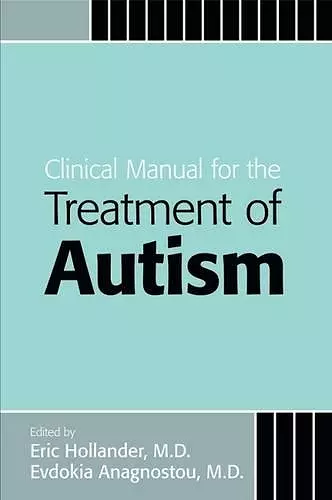Clinical Manual for the Treatment of Autism
Eric Hollander editor Evdokia Anagnostou editor
Format:Paperback
Publisher:American Psychiatric Association Publishing
Published:5th Nov '07
Currently unavailable, and unfortunately no date known when it will be back

Reflecting tremendous gains over the past decade in our understanding of the causes of autism, Clinical Manual for the Treatment of Autism meets the increasing need for clear, up-to-date, and evidence-based treatment. Internationally known researchers—who are also skilled in treating patients with autism—share treatment approaches they have either developed or thoroughly tested for safety and efficacy.
The book describes in a straightforward manner how to diagnose autism, recognizing that patients may vary greatly in intelligence, language ability, disruptive behavior, and presence of comorbid disorders. It outlines the appropriate instruments to use for particular patients, providing examples and guidelines for evaluation and testing of individuals of all ages and levels of functioning, with a focus on initial diagnostic evaluation. It also evaluates the appropriate role of various medications for specific target symptoms and individuals: SSRIs and antidepressants, focusing on the rationale for their use and clinical trials in autism; anticonvulsants and mood stabilizers used to treat disruptive behaviors and mood instability; conventional and atypical antipsychotics, emphasizing studies using random assignment to active and control treatments; cholinesterase inhibitors, focusing on cholinergic mechanisms and treatment experience in autism; and stimulants and nonstimulants for the treatment of pervasive developmental disorder accompanied by hyperactivity, distractibility, and impulsiveness. In addition to pharmacological approaches, the book presents psychosocial treatments and includes well-accepted psychoeducational models for which there is sufficient evidence to recommend their use. In these chapters, the book:
• Covers the use of applied behavior analysis, the DIR/Floortime approach, and peer relationship interventions.
• Presents educational approaches, based on the experience of the TEACCH program in North Carolina, describing how its fundamental principles are utilized across the age spectrum.
• Describes complementary and alternative treatments—such as therapies targeting gastrointestinal function or the immune system or the use of nutritional supplements—with an eye toward helping parents make informed choices.
• Explores promising new avenues of treatment to address issues related to cognition and social and language deficits, focusing particularly on the potential of medications that target the glutamate and oxytocin brain systems.
Clinical Manual for the Treatment of Autism is an essential resource for a broad range of professionals, including psychiatrists, pediatricians, neurologists, psychologists, educators, and behavioral, speech, and occupational therapists. It is a state-of-the-art compendium of treatments that will help advance the care that people with autism receive.
This clinical manual provides a comprehensive discussion of diagnostic issues and treatment options for autism. The many well organized tables also make it a good reference work. Chapters are written clearly and concisely, making the information very accessible to a wife range of mental health clinicians and other medical professionals.
* Journal of Psychiatric Practice *I highly recommend this book for both clinicians and researchers, particularly for the treatment chapters regarding psychopharmacological, complementary and alternative medicine, and behavioral interventions. In a field fraught with controversy, this book adds clarity in a compact and well-written format. This should be read by all who take care of children with autism.
* American Journal of Psychiatry *I highly recommended this book to psychiatrics who see patients with autistic spectrum disorder in their practice and who are in need of straightforward, evidence-based guidelines for evaluation, testing, and treatment. This book is particularly suited for use by physician, as its strength is clearly in the guidance it provides regarding psychopharmacology. Its description of psycho educational approaches is helpful in that it familiarizes the reader with the theory, delivery, and evidence behind them.
* Psychiatric ServicISBN: 9781585622221
Dimensions: 210mm x 140mm x 19mm
Weight: 363g
336 pages